From the Trenches
Do No Harm
By JARRETT A. LOBELL
Tuesday, August 07, 2018
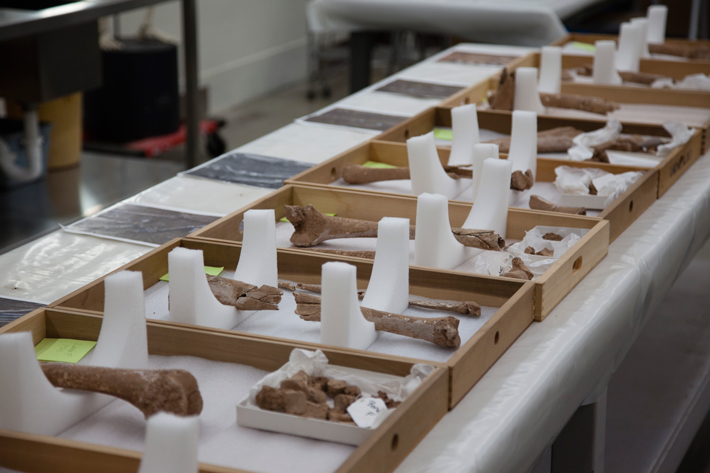 For three days in August of 1862, a small stream called Bull Run near Manassas, Virginia, became the site of one of the most decisive contests of the second year of the Civil War. Just 13 months before, the Battle of First Manassas, also known as the First Battle of Bull Run, had been fought in this same location—but the second engagement was to prove far more deadly. Some 125,000 men were engaged in battle, with 3,021 killed, 15,263 wounded, and an unknown number captured or missing on both sides.
For three days in August of 1862, a small stream called Bull Run near Manassas, Virginia, became the site of one of the most decisive contests of the second year of the Civil War. Just 13 months before, the Battle of First Manassas, also known as the First Battle of Bull Run, had been fought in this same location—but the second engagement was to prove far more deadly. Some 125,000 men were engaged in battle, with 3,021 killed, 15,263 wounded, and an unknown number captured or missing on both sides.
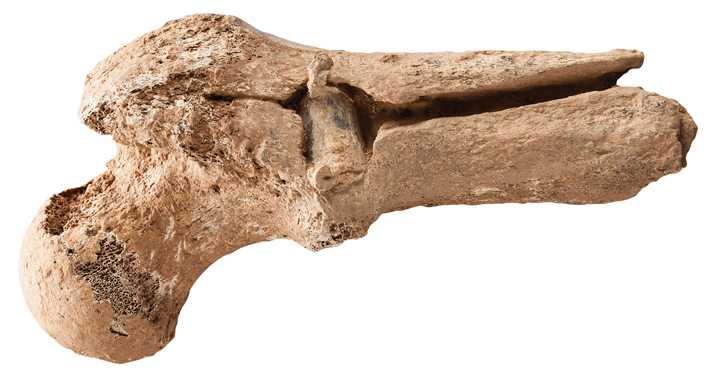 During utility work on the battlefield, archaeologists made a stunning discovery less than a foot below the surface—a surgeon’s burial pit filled with 11 amputated limbs and two nearly complete skeletons, the first such pit ever to be excavated and scientifically studied. Isotopic analysis combined with evidence of uniform buttons and Enfield bullets has revealed that the men were Union soldiers from the Northeast, and that they likely died on the final day of the Battle of Second Manassas (or the Second Battle of Bull Run). Further examination of the bones, and in particular the cuts on the amputated limbs, is enabling scientists at the Smithsonian Institution to appreciate the extraordinary skill of the surgeon involved in making and executing potentially lifesaving decisions during the chaos of battle.
During utility work on the battlefield, archaeologists made a stunning discovery less than a foot below the surface—a surgeon’s burial pit filled with 11 amputated limbs and two nearly complete skeletons, the first such pit ever to be excavated and scientifically studied. Isotopic analysis combined with evidence of uniform buttons and Enfield bullets has revealed that the men were Union soldiers from the Northeast, and that they likely died on the final day of the Battle of Second Manassas (or the Second Battle of Bull Run). Further examination of the bones, and in particular the cuts on the amputated limbs, is enabling scientists at the Smithsonian Institution to appreciate the extraordinary skill of the surgeon involved in making and executing potentially lifesaving decisions during the chaos of battle.
Making an Entrance
By MARLEY BROWN
Tuesday, August 07, 2018
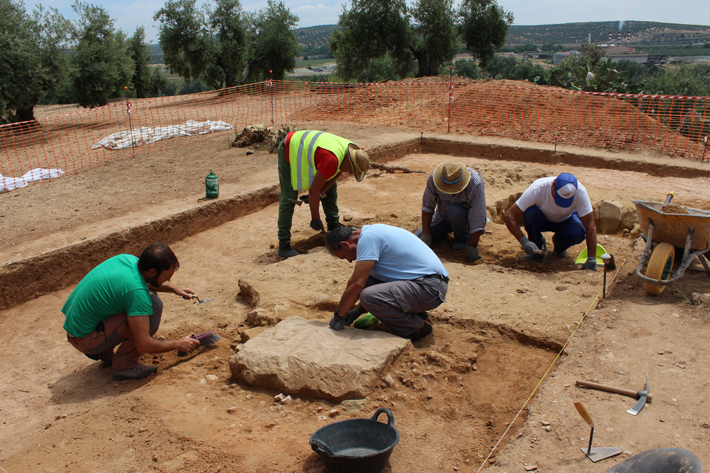 Remains of an imposing arch, believed to have been around 25 feet tall and more than 50 feet wide, that marked the starting point of a road in Roman Iberia, have been uncovered near southern Spain’s city of Mengíbar. According to archaeologist Juan Pedro Bellón of the University of Jaén, the arch of Janus Augustus signaled the beginning of the Hispania Baetica section of the Via Augusta, a nearly 1,000-mile-long road that stretched from the Atlantic through the Pyrenees and connected with routes to Rome. Hispania Baetica, the southernmost Roman province of the Iberian Peninsula, roughly corresponds to Spain’s autonomous community of Andalusia. “We believe that both the Via Augusta and the Janus Augustus arch were part of a transformation of the frontier ordered by the emperor Augustus between 13 and 7 B.C.,” Bellón explains. He says that the discovery of the arch will help reconstruct local territorial boundaries that would have been encountered by invading Romans and will provide important new insight into strategic decisions they made when building infrastructure and monumental symbols of Rome’s power in the region.
Remains of an imposing arch, believed to have been around 25 feet tall and more than 50 feet wide, that marked the starting point of a road in Roman Iberia, have been uncovered near southern Spain’s city of Mengíbar. According to archaeologist Juan Pedro Bellón of the University of Jaén, the arch of Janus Augustus signaled the beginning of the Hispania Baetica section of the Via Augusta, a nearly 1,000-mile-long road that stretched from the Atlantic through the Pyrenees and connected with routes to Rome. Hispania Baetica, the southernmost Roman province of the Iberian Peninsula, roughly corresponds to Spain’s autonomous community of Andalusia. “We believe that both the Via Augusta and the Janus Augustus arch were part of a transformation of the frontier ordered by the emperor Augustus between 13 and 7 B.C.,” Bellón explains. He says that the discovery of the arch will help reconstruct local territorial boundaries that would have been encountered by invading Romans and will provide important new insight into strategic decisions they made when building infrastructure and monumental symbols of Rome’s power in the region.
A Very Long Way to Eat Rhino
By ZACH ZORICH
Tuesday, August 07, 2018

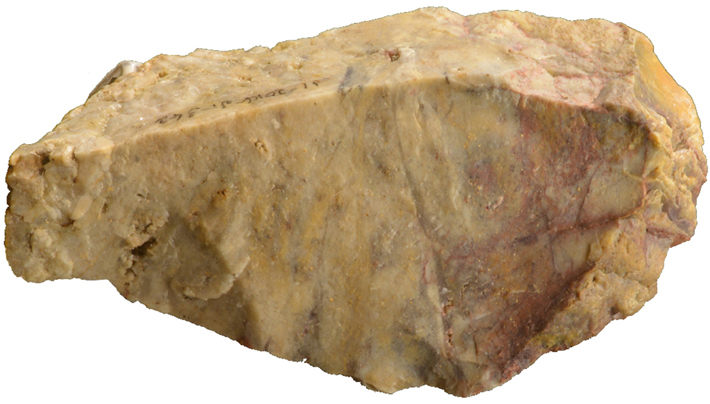 A new discovery on the island of Luzon pushes back the arrival of humans in the Philippines from 67,000 years ago to more than 700,000 years ago. An international team of researchers studied 57 stone tools found at the site of Kalinga alongside rhinoceros bones that show evidence of cut marks made while butchering them. Some of the bones had also been smashed open, suggesting that people were after the nutrient-rich marrow.
A new discovery on the island of Luzon pushes back the arrival of humans in the Philippines from 67,000 years ago to more than 700,000 years ago. An international team of researchers studied 57 stone tools found at the site of Kalinga alongside rhinoceros bones that show evidence of cut marks made while butchering them. Some of the bones had also been smashed open, suggesting that people were after the nutrient-rich marrow.
This discovery supports the suggestion that hominins during the Middle Pleistocene (781,000–126,000 years ago) were able to build watercraft capable of ocean crossings and could navigate the South China Sea to reach Luzon from mainland Asia. At the moment, the researchers are hesitant to pin down which human ancestor may have made the journey, suggesting that it may have been either Homo erectus or early members of the recently identified Denisovans who undertook the journey.
Hold Your Horses
By DANIEL WEISS
Tuesday, August 07, 2018
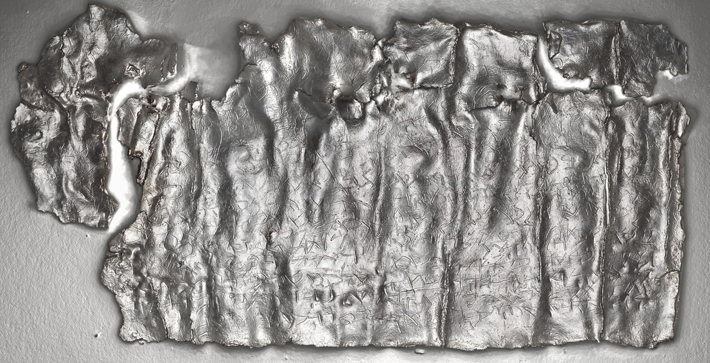 A thin lead curse tablet dating to the fifth century A.D. that was folded and nailed shut to intensify its power has recently been opened, some 80 years after it was discovered beneath the hippodrome in Antioch, in modern-day Turkey. Curse tablets from the period are generally in Greek or Latin, but this one, although difficult to make out with the naked eye, turns out to have been written in a Jewish dialect of Aramaic using Hebrew lettering. “This means it was written by a Jewish scribe,” says Rivka Elitzur-Leiman of Tel Aviv University, “if not a Jewish magician.”
A thin lead curse tablet dating to the fifth century A.D. that was folded and nailed shut to intensify its power has recently been opened, some 80 years after it was discovered beneath the hippodrome in Antioch, in modern-day Turkey. Curse tablets from the period are generally in Greek or Latin, but this one, although difficult to make out with the naked eye, turns out to have been written in a Jewish dialect of Aramaic using Hebrew lettering. “This means it was written by a Jewish scribe,” says Rivka Elitzur-Leiman of Tel Aviv University, “if not a Jewish magician.”
Working around holes in the text where the nail punched through, Elitzur-Leiman and Margaretha Folmer of Leiden University are now deciphering the tablet’s message with photos taken using reflectance transformation imaging. The tablet’s curse seems to have been aimed at disabling opposing horses in a chariot race. It calls on God and his angels to drown the opponents and on a particular angel, who stood in front of Balaam’s donkey in the Book of Numbers, to block the opponents’ way.
Breaking the Mold
By MARLEY BROWN
Tuesday, August 07, 2018
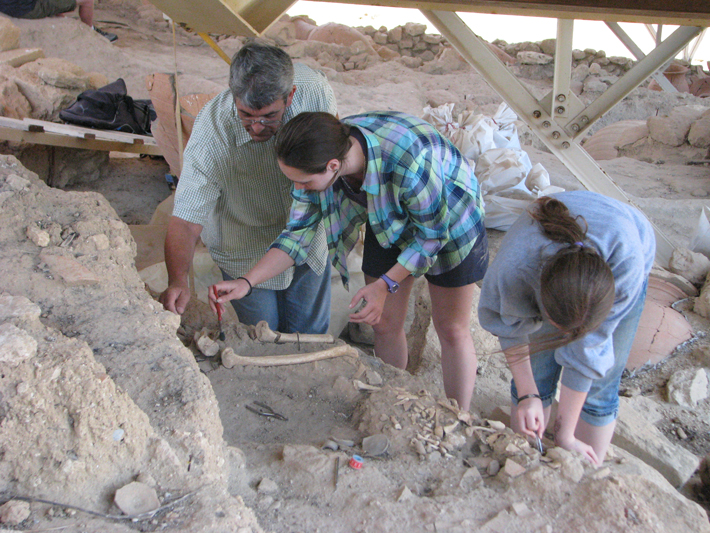 Researchers at Eleutherna, a fortified city-state in Crete that reached its apogee around 800 B.C., have concluded that a woman whose remains were discovered at the site in 2009 spent her life crafting ceramics. Using a range of technology, including medical imaging and anatomical models, the team, led by anthropologist Anagnostis Agelarakis of Adelphi University, found patterns of skeletal wear consistent with years spent seated and working clay on a kick-wheel-operated turntable, making the woman the only known female master ceramicist in the ancient Greek world. Significantly, Eleutherna has an association with women in positions of importance and power. Four women related to one another and thought to have been priestesses were discovered in ornately furnished burials nearby. “While this is a rare discovery in Greek archaeology,” Agelarakis says, “in some ways it is unsurprising given the importance and privileged social position of the Eleuthernian matriline.”
Researchers at Eleutherna, a fortified city-state in Crete that reached its apogee around 800 B.C., have concluded that a woman whose remains were discovered at the site in 2009 spent her life crafting ceramics. Using a range of technology, including medical imaging and anatomical models, the team, led by anthropologist Anagnostis Agelarakis of Adelphi University, found patterns of skeletal wear consistent with years spent seated and working clay on a kick-wheel-operated turntable, making the woman the only known female master ceramicist in the ancient Greek world. Significantly, Eleutherna has an association with women in positions of importance and power. Four women related to one another and thought to have been priestesses were discovered in ornately furnished burials nearby. “While this is a rare discovery in Greek archaeology,” Agelarakis says, “in some ways it is unsurprising given the importance and privileged social position of the Eleuthernian matriline.”
Advertisement
Advertisement
IN THIS ISSUE
From the Trenches
Ice Age Necropolis
Off the Grid
Hellenistic Helmet Safety
All Bundled Up
Spheres of Influence
Hand Picked
Ancient Foresters
Indian Warrior Class
Please Wash Your Hands
Can You Dig It, Man?
Breaking the Mold
A Very Long Way to Eat Rhino
Hold Your Horses
Making an Entrance
Do No Harm
World Roundup
Ancient Japanese peach pits, the weight of Maya prestige, kangaroo cookout, early American smokers, and a lost Illyrian city
Artifact
Not just a pretty base
Advertisement

Recent Issues
-
 May/June 2024
May/June 2024
-
 March/April 2024
March/April 2024
-
 January/February 2024
January/February 2024
-
 November/December 2023
November/December 2023
-
 September/October 2023
September/October 2023
-
 July/August 2023
July/August 2023
-
 May/June 2023
May/June 2023
-
 March/April 2023
March/April 2023
-
 January/February 2023
January/February 2023
-
 November/December 2022
November/December 2022
-
 September/October 2022
September/October 2022
-
 July/August 2022
July/August 2022
-
 May/June 2022
May/June 2022
-
 March/April 2022
March/April 2022
-
 January/February 2022
January/February 2022
-
 November/December 2021
November/December 2021
-
 September/October 2021
September/October 2021
-
 July/August 2021
July/August 2021
-
 May/June 2021
May/June 2021
-
 March/April 2021
March/April 2021
-
 January/February 2021
January/February 2021
-
 November/December 2020
November/December 2020
-
 September/October 2020
September/October 2020
-
 July/August 2020
July/August 2020
-
 May/June 2020
May/June 2020
-
 March/April 2020
March/April 2020
-
 January/February 2020
January/February 2020
-
 November/December 2019
November/December 2019
-
 September/October 2019
September/October 2019
-
 July/August 2019
July/August 2019
-
 May/June 2019
May/June 2019
-
 March/April 2019
March/April 2019
-
 January/February 2019
January/February 2019
-
 November/December 2018
November/December 2018
-
 September/October 2018
September/October 2018
-
 July/August 2018
July/August 2018
-
 May/June 2018
May/June 2018
-
 March/April 2018
March/April 2018
-
 January/February 2018
January/February 2018
-
 November/December 2017
November/December 2017
-
 September/October 2017
September/October 2017
-
 July/August 2017
July/August 2017
-
 May/June 2017
May/June 2017
-
 March/April 2017
March/April 2017
-
 January/February 2017
January/February 2017
-
 November/December 2016
November/December 2016
-
 September/October 2016
September/October 2016
-
 July/August 2016
July/August 2016
-
 May/June 2016
May/June 2016
-
 March/April 2016
March/April 2016
-
 January/February 2016
January/February 2016
-
 November/December 2015
November/December 2015
-
 September/October 2015
September/October 2015
-
 July/August 2015
July/August 2015
-
 May/June 2015
May/June 2015
-
 March/April 2015
March/April 2015
-
 January/February 2015
January/February 2015
-
 November/December 2014
November/December 2014
-
 September/October 2014
September/October 2014
-
 July/August 2014
July/August 2014
-
 May/June 2014
May/June 2014
-
 March/April 2014
March/April 2014
-
 January/February 2014
January/February 2014
-
 November/December 2013
November/December 2013
-
 September/October 2013
September/October 2013
-
 July/August 2013
July/August 2013
-
 May/June 2013
May/June 2013
-
 March/April 2013
March/April 2013
-
 January/February 2013
January/February 2013
-
 November/December 2012
November/December 2012
-
 September/October 2012
September/October 2012
-
 July/August 2012
July/August 2012
-
 May/June 2012
May/June 2012
-
 March/April 2012
March/April 2012
-
 January/February 2012
January/February 2012
-
 November/December 2011
November/December 2011
-
 September/October 2011
September/October 2011
-
 July/August 2011
July/August 2011
-
 May/June 2011
May/June 2011
-
 March/April 2011
March/April 2011
-
 January/February 2011
January/February 2011
Advertisement






